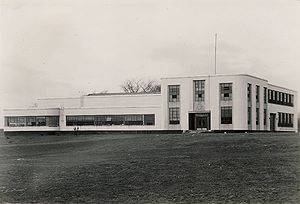Building M-23, Ottawa
| Building M-23 | |
|---|---|
| Part of NRC Campus, Ottawa | |
 | |
| Coordinates | |
| Built | circa 1943 |
Building History
The development of a new research campus began in 1938, sprawling North-West of the corner of Blair and Montreal Roads, east of Ottawa’s core. This location was quite far from the city, and this was quite deliberate. The research taking place here was top secret and kept a mystery. This was even truer with the onset of the Second World War, and the campus remained mysterious to the public until well after the war.[1]
Building M-23 was built about 1942/43 for what was then known as the Canadian Signals Experimental Establishment. The building, and the campus as a whole, is built in the Streamline Moderne style to display the high tech and efficiency of the day.[2]
Building Occupancy
The Royal Canadian Corps of Signals units that occupied the building were a string of engineering units that underwent various role and name changes. During the Second World War, the Canadian Signals Experimental Establishment was a growing concern and required more space. Around 1943 the unit moved into Building M-23 at what was known as the National Research Council (NRC) Annex. In 1943 the unit was redesignated Signals Research and Development Establishment, R.C. Sigs[3] followed by Canadian Signals Research and Development Establishment (CSRDE) in 1946.[4]
In it's infancy, the Defence Research Electronics Laboratory (now the Canadian Research Council (CRC)) was housed temporarily by the Army's CSRDE where they were working on communications equipment problems. The group originally worked in three rooms in the main CSRDE building, but a temporary hut was soon erected and was used as a laboratory until a permanent building could be constructed adjacent to the CSRDE in the NRC compound.[5]
In 1954 the unit was redesignated Canadian Army Signals Engineering Establishment (CASEE)[6] Effective 31 August 1958, the unit was amalgamated with Engineer Stores Development Establishment and Vehicle Experimentation and Proving Establishment to form Army Development Establishment[7] (ADE). ADE successively became the Army Equipment Engineering Establishment and later the Land Engineering and Test Establishment with the Signals portion being E Squadron.
The Signals occupancy of the building ended in 1994 when, as part of cut backs, LETE was disbanded. A plaque was placed on the building listing the units that had served there along with a request that when the building was demolished, the headstone and crest above the door be given to the Canadian Forces Communications Museum.
The current Department of National Defence occupants of the building are the Canadian Forces Joint Imagery Centre (CFJIC).
Related Pages
- No related pages at this time
Related Items
References
- ↑ Kalman, Exploring Ottawa, page 177.
- ↑ Streamlining at the Montreal Road Campus
- ↑ General Order 264/43 effective 1 Dec 1941
- ↑ SD1 Letter 3310 effective 1 Oct 1946
- ↑ Friends of the CRC - A Brief History of CRC
- ↑ Canadian Army Order 76-2, Issue No. 403/54 effective 17 Aug 54.
- ↑ SD1 Letter 58/60, 27 Aug 1958






